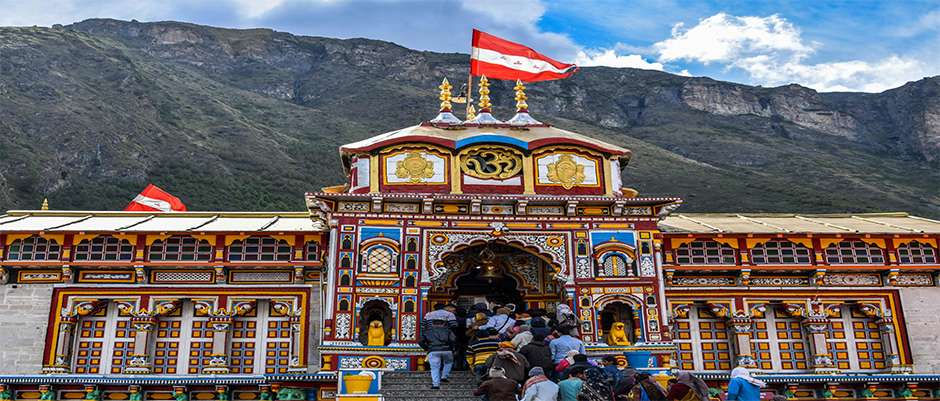
Badrinath Temple
Badarinath Tirtha
The name Badarinath is believed to have originated from Badari, a wild berry that grows abundantly in the region and holds symbolic value in the local tradition. According to legend, when Lord Vishnu undertook deep meditation in the Himalayas, His divine consort, Goddess Lakshmi, transformed herself into a Badari tree to offer Him shade from the blazing sun. This revered location is not only associated with Lord Vishnu but has also served as a spiritual haven for numerous sages and seekers in pursuit of enlightenment.
The Skanda Purana narrates that the idol of Lord Badarinath was originally found in Narad Kund by Adi Guru Shankaracharya, who reinstalled it in the temple during the 8th century A.D.
In accordance with Hindu tradition, Badarinath—also known as Badari Vishal—was revived and sanctified by Adi Shankaracharya with the intent of restoring the declining prestige of Hinduism and fostering unity across the land. This was a time when Buddhism had a strong presence in the Himalayan regions, and the Hindu faith was seen to be in decline. Shankaracharya’s mission led him to establish temples dedicated to deities such as Shiva and Vishnu throughout the Himalayas, among which Badarinath stands as a prominent shrine.
The temple is steeped in stories from ancient scriptures, including the tale of the Pandava brothers and Draupadi, who are believed to have passed this place during their final pilgrimage toward Swargarohini, the peak symbolizing their journey to heaven.
The Skanda Purana speaks highly of this holy location, emphasizing its unmatched spiritual importance across all realms:
"Among all the holy shrines in heaven, on earth, and in the underworld, none equals Badarinath."
According to the Vamana Purana, this is the sacred ground where the twin sages Nara and Narayana, manifestations of Lord Vishnu’s fifth incarnation, are said to have meditated in deep austerity.
Many revered sages of ancient times—such as Kapila Muni, Gautama, and Kashyapa—have meditated in this sacred region. Narada is said to have attained liberation here, and Lord Krishna was deeply drawn to this land. In later centuries, saints and philosophers like Adi Shankaracharya, Ramanujacharya, Sri Madhavacharya, and Sri Nityananda visited the site for contemplation and study. Even today, it remains a place of deep spiritual reflection for many.
The temple’s main entrance, famously known as Singhdwar, is a striking and colorful gateway. The temple structure stands about 50 feet high, crowned with a gold-gilded cupola. From an architectural perspective, the temple consists of three distinct sections, each serving a unique spiritual function:
Garbha Griha (Sanctum Sanctorum)
Darshan Mandap (Hall for Ritual Viewing)
Sabha Mandap (Assembly Hall for Pilgrims)
At the entrance to the temple, directly across from the central deity, is the seated figure of Garuda, the divine vehicle of Lord Badarinath, depicted in a posture of reverence with folded hands. Delicate and detailed carvings embellish the walls and pillars of the mandapa, showcasing traditional craftsmanship.
Inside the Garbha Griha, the sanctum's canopy is lined with gold. This chamber houses the main deity Lord Badarinath, along with images of Kubera, Narada Rishi, Uddhava, and the twin sages Nara and Narayana. The temple houses a group of fifteen sacred idols, each representing important figures from Hindu spiritual lore.
Particularly captivating is the one-meter-tall black stone idol of Lord Badarinath, carved from Saligram stone. As per legend, Adi Shankara originally discovered this idol in the Alaknanda River near the Tapt Kund hot springs, and it was later relocated to its present location in the 16th century by the King of Garhwal. The idol portrays Vishnu seated in a meditative Padmasana posture.
In the Darshan Mandap, Lord Badarinath is depicted holding a conch (Shankha) and discus (Chakra) in two raised hands, while the other two arms rest in a meditative yogic gesture. Lord Badarinath is depicted seated beneath the revered Badari tree, with Uddhava positioned nearby on His right, and the sages Nara and Narayana placed further to that side. Narada Muni kneels in the front, though partly obscured. To His left are Kubera, the guardian of wealth, and a silver-hued Ganesha. In front, Garuda, His devoted mount, is shown kneeling in worshipful reverence.
The Sabha Mandap serves as a spacious hall within the temple complex where pilgrims gather and participate in collective worship and rituals.
Daily Pujas & Timings:1. Abhishek Puja – 4:30am to 6:30am
2. Akhand Jyoti One Day (Non Attending) – As Per Norms
3. Astotari Puja – Between 5pm to 7pm (5-10 mins)
4. Chandi Arti – Between 5pm to 7pm (5-10 mins)
5. Entire Pujas of a Day – Morning till Evening
6. Geeta Path – Morning 7:30am to 12 Noon & Evening 3pm to 5pm
7. Karpoor Arti – Between 5pm to 7pm (5-10 mins)
8. Maha-Abhishek Puja – 4:30am to 6:30am
9. Shayan Aarti with Geet Govind Path – End of the Day
10. Shrimad Bhagwat Sapth Path – For One Week
11. Swaran Aarti – Between 5pm to 7pm (5-10 mins)
12. Ved Path – Morning 7:30am to 12 Noon & Evening 3pm to 5pm
13. Vishnusahasranam Path – Between 6pm to 9pm (10-15 mins)
14. Vishnusahasranamawali Path – Between 5pm to 7pm (5-10 mins)
